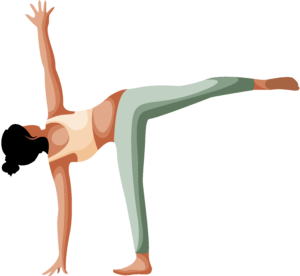Half Moon (Ardha Chandrasana)
Pose Overview
| Common Name | Half Moon |
| Traditional Sanskrit Name | Ardha Chandrasana |
| Sanskrit Name Pronunciation | ard-hah chand-rah-sah-na |
| Pose Difficulty | Intermediate |
| Drishti
Drishti is the gaze or visual focus point during yoga poses.
Learn more about Drishti |
Upward, towards the sky |
Half Moon, or Ardha Chandrasana in Sanskrit, is a standing yoga pose that is said to be beneficial for strengthening the core, legs and arms, as well as for increasing balance and stability. The name of the pose comes from the fact that it resembles a half-moon shape, with one arm extended upward and the other arm extended downward. The pose is said to be helpful for improving balance and stability, and for relieving tension in the lower back and hips.
Benefits of Half Moon
Improves balance, strengthens the core, legs, and spinal muscles, opens the chest, stretches the hips, and improves digestion.
How to Enter Half Moon
Stand in mountain pose (Tadasana) Take a step back with one foot, keeping both feet parallel Place your back foot at a 45-degree angle and ground down through the back foot Bring your arms up to the side, parallel to the ground, with the palms facing down Engage the core, and begin to hinge forward from the hips, keeping the front knee straight Keep the arms parallel to the ground as you reach forward, bringing your chest towards your thigh Keep the gaze forward and lift the back leg off the ground Keep the lifted leg strong and engage the glutes to maintain balance
How to Exit Half Moon
Lower the back leg back to the ground Release the arms and come back to mountain pose (Tadasana)
Common Half Moon Modifications & Variations
For added stability, you can use a block under the hand that is reaching forward To deepen the stretch, you can bring the opposite hand to the hip or ankle of the lifted leg
Common Mistakes with Half Moon
Locking the front knee Rounding the back Not engaging the core Not lifting the back leg high enough
Safety Guidance
Keep the front knee straight to protect the knee joint Keep the core engaged to support the lower back Keep the gaze forward to maintain balance Avoid this pose if you have any injury to the back, knee, or ankle

